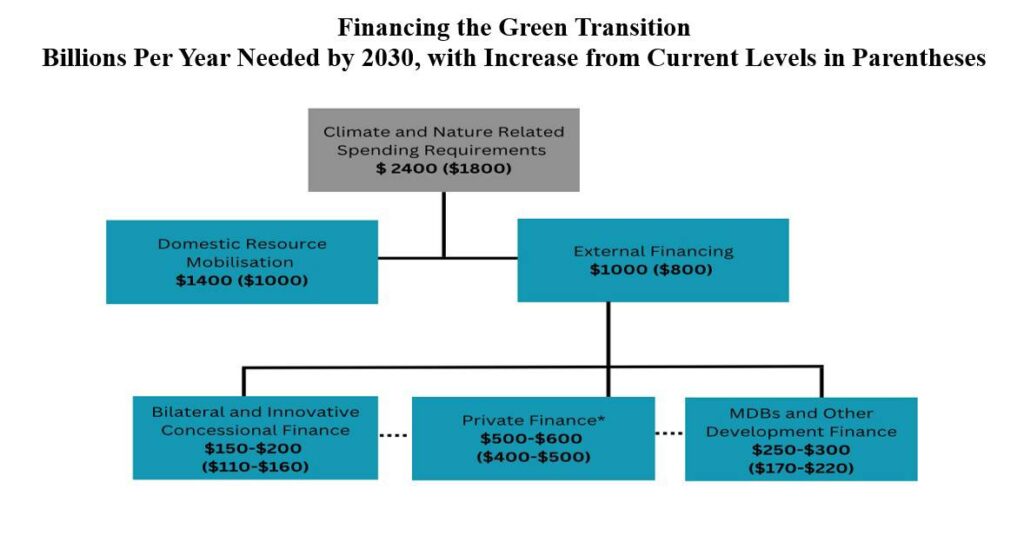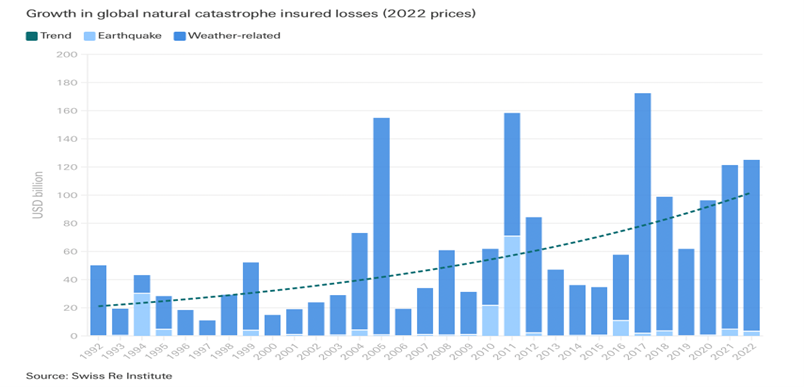Originally published at Project-Syndicate | Sep 22nd, 2023
Between now and the end of this decade, climate-related investments need to increase by orders of magnitude to keep the world on track toward achieving even more ambitious targets by mid-century. Fortunately, if done right, such investments could usher in an entirely new and better economy.
LONDON – With climate risks multiplying, the advanced economies’ pandemic-era policies have created a deeply uncertain future. The world now faces the triple challenge of stabilizing developed economies, accelerating progress toward net-zero emissions, and ensuring that emerging-market and frontier economies can access the capital they need to grow and protect their citizens. That calls for additional financial resources on a massive scale.
In responding to the COVID-19 crisis, policymakers in advanced economies introduced both massive debt-financed fiscal stimulus to shield businesses and households and ultra-loose monetary policies to maintain liquidity in the economy. While these measures succeeded in averting recession, corporate bankruptcies, and increased poverty, they also combined with supply-chain disruptions and Russia’s war in Ukraine to cause the highest inflation in over four decades. Central banks have since responded with repeated interest-rate hikes, contributing to tighter monetary conditions globally. Now, dozens of developing countries are facing debt problems, owing to the sharp and sudden increase in their borrowing costs.
Advanced and developing economies alike have demonstrated great resilience to this volatile economic environment, with some – including India and a few African economies – even maintaining robust growth. But risks are mounting. Over 60% of Africa’s low-income economies are in debt distress, Europe has been teetering on the brink of recession, US markets are volatile, and China’s recovery has faltered. Moreover, risks to financial stability have grown as banks and other financial institutions’ balance sheets have come under pressure from rising interest rates.
Worst of all, global warming is quickly becoming more destructive, leading UN Secretary-General António Guterres to warn that we have reached the “climate cliff.” The Intergovernmental Panel on Climate Change calculates that to keep global average temperatures within 1.5° Celsius of pre-industrial levels, we need to reduce greenhouse-gas emissions by 45% (from 2010 levels) by 2030 and achieve net-zero emissions by 2050. According to the Network for Greening the Financial System, that will require a total capital investment of more than $275 trillion by 2050.
These numbers will increase exponentially if action is delayed. Therefore, massive additional financing must be unlocked immediately.
THE NATURE OF THE PROBLEM
Fortunately, if done right, such investments could usher in a new growth impetus for economies capable of meeting not only the Paris climate agreement’s targets but also the Sustainable Development Goals (SDGs). In Finance for Climate Action, a Grantham Research Institute report that I co-authored with Nicholas Stern and Amar Bhattacharya, we find that spending on climate-related development goals will need to increase fourfold from its pre-pandemic levels by 2030 to address the problem.
Across emerging markets and developing economies other than China, that means spending $2.4 trillion per year (by the end of this decade) on three key objectives: transforming energy systems; building climate resilience; and supporting natural capital and sustainable agriculture. And to achieve the SDGs more broadly, overall development spending (including the $2.4 trillion) must more than double from its pre-pandemic level, to around $5.3 trillion per year by 2030.

Yet most countries have been backsliding on their climate commitments, especially since Russia’s war on Ukraine. Previously decommissioned coal-fired power plants are back in operation in Europe, and new fossil-fuel exploration permits are being awarded in the United States. Key countries are failing to contribute their fair share, thus undermining the principle of common but differentiated responsibilities (which is enshrined in both the Paris agreement and the Kyoto Protocol). Advanced economies have yet to honor their 15-year-old promise of providing at least $100 billion per year for climate adaptation and mitigation in developing countries.
The new “loss and damage” facility announced at last year’s United Nations Climate Change Conference (COP27) was a welcome development, and other bodies – such as the International Development Association, the Green Climate Fund, the African Development Fund, the Resilience and Sustainability Trust, and the Poverty Reduction and Growth Trust – are helping to address funding and allocation gaps in the global financial architecture. But all these mechanisms will need to be properly funded.
Equally important, developing countries must not be made to incur additional debt to address the climate crisis. Although Africa accounts for only 4% of global emissions, it is already spending 5-15% of its GDP responding to climate shocks, and these outlays are crowding out other development priorities and adding to governments’ debt obligations. This will continue until developed countries craft a robust framework for managing debt pressures. The G20’s Common Framework remains unsatisfactory.
Multilateral development banks will be crucial for closing the massive global climate financing gap. But they, too, will need more funding from developed countries, so that they can provide development funds and help crowd-in more private-sector capital. There is no question that low- and middle-income countries will need additional concessional finance (lending on terms more generous than the market offers). Fortunately, we now have a wide variety of debt-free financing options, from issuing new special drawing rights (the International Monetary Fund’s unit of account) to levying global carbon taxes on the airline and maritime sectors, cracking down on illicit financial flows, developing transparent carbon markets, and leveraging private philanthropy.
But we also must do more to attract private-sector capital. That will require credit enhancements and de-risking tools to protect investments and deliver a worthwhile risk-adjusted rate of return. With new banking rules being adopted under the Basel Framework, regulators must be careful not to reduce the availability of capital or impose prohibitively high costs on emerging markets.
THE INNOVATION FACTOR
Financial innovation is key. We need more resources, but we also need to deploy them differently than in the past. In recent years, the market for sustainable finance has expanded rapidly as countries, companies, and investors look for footholds in the new climate economy. There has been plenty of innovation to crowd in affordable financing for priority sectors such as energy, land, agriculture and biodiversity, transportation, and construction. But the challenge is getting the private sector and the development community to work more closely together.
The most prevalent innovations today are sustainable (green or social) bonds, loans that are tied to ESG (environmental, social, governance) performance, and municipal bonds to finance environmental and social goods. Other instruments include debt-for-climate swaps, schemes to finance sustainable supply chains, and various sustainability-focused lending and investment initiatives. Sustainable debt issuance (which includes “social” and other areas not directly related to the energy transition) is projected to increase to $1.7 trillion in 2023, according to the Institute of International Finance.
Moreover, such issuances are multiplying. For example, Citibank, the World Bank, and South Africa recently issued a first-of-its-kind outcome-based Wildlife Conservation Bond that aims to protect and increase the population of black rhinos in two protected areas. Debt-for-nature swaps are also gaining ground and bringing together the private sector, philanthropic organizations, and development partners. Blue Bonds for Ocean Conservation – a joint effort with the US Development Finance Corporation, The Nature Conservancy, Credit Suisse, and AXA – helped Belize lower its high debt-service burden by buying back its existing debt at a discount, thereby tripling the country’s budget for marine-conservation programs.
Reducing the cost of market access remains an important issue for developing countries. With bond-market spreads for emerging economies at unaffordable levels, new initiatives such as the Liquidity and Sustainability Facility are being developed to create a secondary market for European, Middle Eastern, and African bonds. That should help both to drive down spreads and crowd in more investors.
There is also an expanding menu of blended finance options from which investors and developers can choose, based on their risk tolerance. And more philanthropic organizations are showing a willingness to take first losses, or to supply grant resources to support project preparation and early-stage development – as the Global Energy Alliance for People and Planet has done.
But the climate crisis also poses new kinds of financial-stability risk that will require new and innovative tools to manage. In 2021 alone, natural disasters caused an estimated $270 billion in economic losses, only $111 billion of which were insured. Having seen the writing on the wall, the insurance sector is innovating to support adaptation efforts and to build a more robust business, including by developing new risk-assessment tools, indices, and methodologies. The Ocean Risk and Resilience Action Alliance, for example, is working to improve how vessels are evaluated for insurance purposes, and to ensure that criteria on illegal, unreported, and unregulated fishing are included in underwriting guidelines.

More broadly, carbon-credit markets are offering ways for companies to work toward their net-zero pledges as they adopt cleaner technologies and processes, as well as providing resources for cities and local communities in the Global South to undertake sustainable-development projects. In Uganda, carbon credits have paid for the local manufacturing and distribution of cleaner, cost-efficient cookstoves, which are both reducing emissions, improving people’s health, and saving families money through reduced fuel costs (amounting to more than $75 million, so far).
These early success stories show that there is a clear path out of our “polycrisis.” We need increased concessional resources coupled with financial and technological innovations to deliver growth over the next quarter-century. The challenge now is to muster the political will to change our current course.
Vera Songwe: Chair of the Liquidity and Sustainability Facility, is a non-resident senior fellow at the Brookings Institution and Co-Chair of the High-Level Expert Group on Climate Finance.



